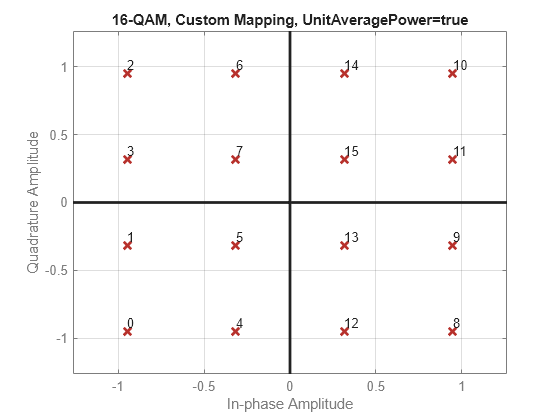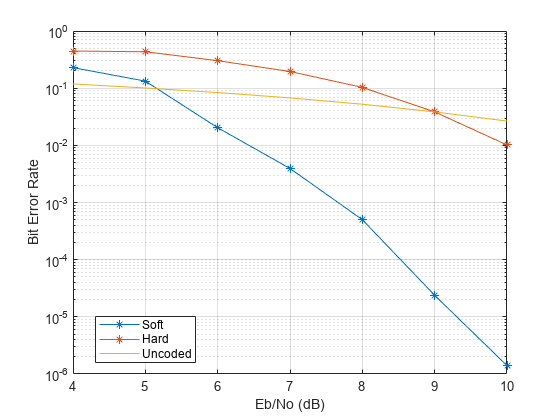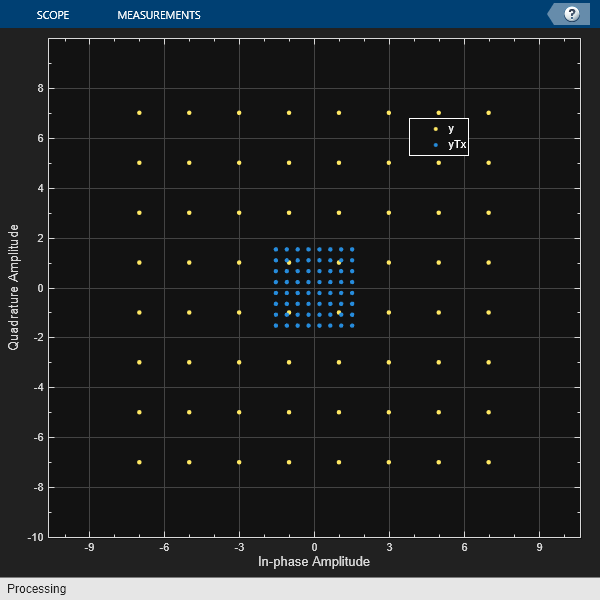qamdemod
Quadrature amplitude demodulation
Description
Z = qamdemod(___,Name=Value)OutputType=bit sets the type of output signal to bits.
Examples
Demodulate an 8-QAM signal and plot the points corresponding to symbols 0 and 3.
Generate random 8-ary data symbols.
data = randi([0 7],1000,1);
Modulate data by applying 8-QAM.
txSig = qammod(data,8);
Pass the modulated signal through an AWGN channel.
rxSig = awgn(txSig,18,'measured');Demodulate the received signal using an initial phase of /8.
rxData = qamdemod(rxSig.*exp(-1i*pi/8),8);
Generate the reference constellation points.
refpts = qammod((0:7)',8) .* exp(1i*pi/8);
Plot the received signal points corresponding to symbols 0 and 3 and overlay the reference constellation. The received data corresponding to those symbols is displayed.
plot(rxSig(rxData==0),'g.'); hold on plot(rxSig(rxData==3),'c.'); plot(refpts,'r*') text(real(refpts)+0.1,imag(refpts),num2str((0:7)')) xlabel('In-Phase') ylabel('Quadrature') legend('Points corresponding to 0','Points corresponding to 3', ... 'Reference constellation','location','nw');

Modulate and demodulate random data by using 16-QAM with WLAN symbol mapping. Verify that the input data symbols match the demodulated symbols.
Generate a 3-D array of random symbols.
x = randi([0,15],20,4,2);
Create a custom symbol mapping for the 16-QAM constellation based on WLAN standards.
wlanSymMap = [2 3 1 0 6 7 5 4 14 15 13 12 10 11 9 8];
Modulate the data, and set the constellation to have unit average signal power. Plot the constellation.
y = qammod(x,16,wlanSymMap, ... UnitAveragePower=true, ... PlotConstellation=true);

Demodulate the received signal.
z = qamdemod(y,16,wlanSymMap, ...
UnitAveragePower=true);Verify that the demodulated signal is equal to the original data.
isequal(x,z)
ans = logical
1
Demodulate a fixed-point QAM signal and verify that the data is recovered correctly.
Set the modulation order as 64, and determine the number of bits per symbol.
M = 64; bitsPerSym = log2(M);
Generate random bits. When operating in bit mode, the length of the input data must be an integer multiple of the number of bits per symbol.
x = randi([0 1],10*bitsPerSym,1);
Modulate the input data using a binary symbol mapping. Set the modulator to output fixed-point data. The numeric data type is signed with a 16-bit word length and a 10-bit fraction length.
y = qammod(x,M,'bin', ... InputType='bit', ... OutputDataType=numerictype(1,16,10));
Demodulate the 64-QAM signal. Verify that the demodulated data matches the input data.
z = qamdemod(y,M,'bin',OutputType='bit'); s = isequal(x,double(z))
s = logical
1
Estimate bit error rate (BER) performance for hard-decision and soft-decision Viterbi decoders in AWGN. Compare the performance to that of an uncoded 64-QAM link.
Set the simulation parameters.
rng default M = 64; % Modulation order k = log2(M); % Bits per symbol EbNoVec = (4:10)'; % Eb/No values (dB) numSymPerFrame = 1000; % Number of QAM symbols per frame
Initialize the BER results vectors.
berEstSoft = zeros(size(EbNoVec)); berEstHard = zeros(size(EbNoVec));
Set the trellis structure and traceback depth for a rate 1/2, constraint length 7, convolutional code.
trellis = poly2trellis(7,[171 133]); tbl = 32; rate = 1/2;
The main processing loops perform these steps:
Generate binary data
Convolutionally encode the data
Apply QAM modulation to the data symbols. Specify unit average power for the transmitted signal
Pass the modulated signal through an AWGN channel
Demodulate the received signal using hard decision and approximate LLR methods. Specify unit average power for the received signal
Viterbi decode the signals using hard and unquantized methods
Calculate the number of bit errors
The while loop continues to process data until either 100 errors are encountered or bits are transmitted.
for n = 1:length(EbNoVec) % Convert Eb/No to SNR snrdB = EbNoVec(n) + 10*log10(k*rate); % Noise variance calculation for unity average signal power noiseVar = 10.^(-snrdB/10); % Reset the error and bit counters [numErrsSoft,numErrsHard,numBits] = deal(0); while numErrsSoft < 100 && numBits < 1e7 % Generate binary data and convert to symbols dataIn = randi([0 1],numSymPerFrame*k,1); % Convolutionally encode the data dataEnc = convenc(dataIn,trellis); % QAM modulate txSig = qammod(dataEnc,M, ... InputType='bit', ... UnitAveragePower=true); % Pass through AWGN channel rxSig = awgn(txSig,snrdB,'measured'); % Demodulate the noisy signal using hard decision (bit) and % soft decision (approximate LLR) approaches. rxDataHard = qamdemod(rxSig,M, ... OutputType='bit', ... UnitAveragePower=true); rxDataSoft = qamdemod(rxSig,M, ... OutputType='approxllr', ... UnitAveragePower=true, ... NoiseVariance=noiseVar); % Viterbi decode the demodulated data dataHard = vitdec(rxDataHard,trellis,tbl,'cont','hard'); dataSoft = vitdec(rxDataSoft,trellis,tbl,'cont','unquant'); % Calculate the number of bit errors in the frame. % Adjust for the decoding delay, which is equal to % the traceback depth. numErrsInFrameHard = ... biterr(dataIn(1:end-tbl),dataHard(tbl+1:end)); numErrsInFrameSoft = ... biterr(dataIn(1:end-tbl),dataSoft(tbl+1:end)); % Increment the error and bit counters numErrsHard = numErrsHard + numErrsInFrameHard; numErrsSoft = numErrsSoft + numErrsInFrameSoft; numBits = numBits + numSymPerFrame*k; end % Estimate the BER for both methods berEstSoft(n) = numErrsSoft/numBits; berEstHard(n) = numErrsHard/numBits; end
Plot the estimated hard and soft BER data. Plot the theoretical performance for an uncoded 64-QAM channel.
semilogy(EbNoVec,[berEstSoft berEstHard],'-*') hold on semilogy(EbNoVec,berawgn(EbNoVec,'qam',M)) legend('Soft','Hard','Uncoded','location','best') grid xlabel('Eb/No (dB)') ylabel('Bit Error Rate')

As expected, the soft decision decoding produces the best results.
Use the qamdemod function to simulate soft decision output for OQPSK-modulated signals.
Generate an OQPSK modulated signal.
sps = 4; msg = randi([0 1],1000,1); oqpskMod = comm.OQPSKModulator( ... SamplesPerSymbol=sps, ... BitInput=true); oqpskSig = oqpskMod(msg);
Add noise to the generated signal.
impairedSig = awgn(oqpskSig,15);
Perform Soft-Decision Demodulation
Create QPSK equivalent signal to align in-phase and quadrature.
impairedQPSK = complex( ... real(impairedSig(1+sps/2:end-sps/2)), ... imag(impairedSig(sps+1:end)));
Apply matched filtering to the received OQPSK signal.
halfSinePulse = sin(0:pi/sps:(sps)*pi/sps);
matchedFilter = dsp.FIRDecimator(sps,halfSinePulse, ...
DecimationOffset=sps/2);
filteredQPSK = matchedFilter(impairedQPSK);To perform soft demodulation of the filtered OQPSK signal use the qamdemod function. Align symbol mapping of qamdemod with the symbol mapping used by the comm.OQPSKModulator, then demodulate the signal.
oqpskModSymbolMapping = [1 3 0 2]; demodulated = qamdemod(filteredQPSK,4,oqpskModSymbolMapping, ... OutputType='llr');
Apply average power normalization for hard decision output when using qammod and qamdemod functions by using the helperAvgPow2MinD utility function. Scale the constellation to the normalized average power, and then plot the reference and scaled constellations.
Compute the minimum distance for symbols based on specified average power and modulation order.
M = 64; avgPwr = 2; minD = helperAvgPow2MinD(avgPwr,M);
Modulate a signal composed of random integers in the range [0, M - 1], scale the modulated symbols.
x = randi([0,M-1],1000,1); y = qammod(x,M); yTx = (minD/2) .* y;
Verify signal average power approximately equals the specified average power, avgPow.
sigPwr = mean(abs(yTx).^2)
sigPwr = 2.0141
avgPwr
avgPwr = 2
Assign the transmitted signal to the receive signal without applying any RF or channel impairments. With no impairments to distort the received signal, the demodulated matches the original signal. Demodulate symbols using hard decisions, and confirm correct signal demodulation.
yRx = yTx; z = qamdemod(yRx*2/minD,M); checkDemodIsEqual = isequal(x,z)
checkDemodIsEqual = logical
1
refC = qammod([0:M-1]',M);
Show constellation
maxAx = ceil(max(abs(refC))); cd = comm.ConstellationDiagram(2, ... 'ShowReferenceConstellation',0, ... 'ShowLegend',true, ... 'XLimits',[-(maxAx) maxAx],'YLimits',[-(maxAx) maxAx], ... 'ChannelNames', ... {'y','yTx'}); cd(y,yTx)

Apply peak power normalization for hard decision output when using qammod and qamdemod functions by using the helperPeakPow2MinD utility function. Scale the constellation to the normalized peak power, and then plot the reference and scaled constellations.
Compute the minimum distance for symbols based on specified peak power and modulation order.
M = 16; pkPwr = 30; minD = helperPeakPow2MinD(pkPwr,M);
Modulate a signal composed of random integers in the range [0, M - 1], scale the modulated symbols.
x = randi([0,M-1],1000,1); y = qammod(x,M); yTx = (minD/2) .* y;
Verify signal peak power approximately equals the specified peak power, pkPow.
sigPwr = max(abs(yTx).^2)
sigPwr = 30
pkPwr
pkPwr = 30
Assign the transmitted signal to the receive signal without applying any RF or channel impairments. With no impairments to distort the received signal, the demodulated matches the original signal. Demodulate symbols using hard decisions, and confirm correct signal demodulation.
yRx = yTx; z = qamdemod(yRx*2/minD,M); checkDemodIsEqual = isequal(x,z)
checkDemodIsEqual = logical
1
refC = qammod([0:M-1]',M);
Show constellation
maxAx = ceil(max(abs(refC))); cd = comm.ConstellationDiagram(2, ... 'ShowReferenceConstellation',0, ... 'ShowLegend',true, ... 'XLimits',[-(maxAx) maxAx],'YLimits',[-(maxAx) maxAx], ... 'ChannelNames', ... {'y','yTx'}); cd(y,yTx)

Input Arguments
Input signal that resulted QAM, specified as a scalar, vector, matrix, or 3-D array of complex values. Each column in the matrix and 3-D array is considered as an independent channel.
Data Types: double | single | fi
Complex Number Support: Yes
Modulation order, specified as a positive integer power of two. The modulation order specifies the number of points in the signal constellation.
Data Types: double | single | int8 | int16 | int32 | int64 | uint8 | uint16 | uint32 | uint64
Symbol order, specified as one of these options:
'gray'— Use Gray-coded ordering. For more information, see Gray Code.'bin'— Use binary-coded ordering.Vector — Use custom symbol ordering. The vector must be of length
M. Vectors must use unique elements values in the range [0, (M– 1)]. The first element corresponds to the upper left point of the constellation, with subsequent elements running down column-wise from left to right.
Data Types: string | char | double | single | int8 | int16 | int32 | int64 | uint8 | uint16 | uint32 | uint64
Name-Value Arguments
Specify optional pairs of arguments as
Name1=Value1,...,NameN=ValueN, where Name is
the argument name and Value is the corresponding value.
Name-value arguments must appear after other arguments, but the order of the
pairs does not matter.
Before R2021a, use commas to separate each name and value, and enclose
Name in quotes.
Example: Z = qamdemod(Y,M,symOrder,'OutputType','bit')
Option to scale constellation to unit average power, specified as a numeric or
logical 0 (false) or 1
(true).
When set to
true, the function scales the constellation to the average power of one watt referenced to 1 ohm.When set to
false, the function scales the constellation so that the QAM constellation points are separated by a minimum distance of two.
Type of output, specified as 'integer',
'bit', 'llr', or
'approxllr'.
Output data type, specified as 'double',
'single', 'uint8' ,
'uint16', 'uint32', 'int8'
'int16', 'int32', or
'logical'. This argument determines the final data type of the
output modulated symbols.
When you specify
OutputTypeas'integer'or'bit', you can specify the output data type as'double','single','uint8','uint16','uint32','int8''int16', or'int32'.When you specify
OutputTypeas'bit', you can also specify the output data type as'logical'.When you specify
OutputTypeas'llr'or'approxllr', this argument is ignored and the output data type is same as the data type of inputY.If you do not specify this argument, the output data type is same as the data type of input
Yfor floating pointYanduint1for fixed-pointY.
Noise variance, specified as a positive scalar or a vector of positive values. When you set this argument to a:
Positive scalar — The same noise variance value is used on all input elements.
Vector of positive values — The vector length must be equal to the number of elements in the last dimension of the input signal. Each element of the vector specifies the noise variance for all the elements of the input along the corresponding last dimension.
Tips
The exact LLR algorithm computes exponentials using finite precision arithmetic. For computations involving very large positive or negative magnitudes, the exact LLR algorithm yields:
Infor-Infif the noise variance is a very large valueNaNif the noise variance and signal power are both very small values
The approximate LLR algorithm does not compute exponentials. You can avoid
Inf, -Inf, and NaN results by using
the approximate LLR algorithm.
Dependencies
To enable this name-value pair argument, set OutputType is 'llr' or
'approxllr'.
Option to plot constellation, specified as a numeric or logical
0 (false) or 1
(true) To plot the QAM constellation, specify
PlotConstellation=true.
Output Arguments
Demodulated output signal, returned as a scalar, vector, matrix, or 3-D array. The
data type is the same as that of the input signal, Y. The value and
dimension of this output vary depending on the specified OutputType
value, as shown in this table.
'OutputType' | Return Value of qamdemod | Dimensions of Output |
|---|---|---|
'integer' | Demodulated integer values in the range [0, (M – 1)] | Z has the same dimensions as input Y. |
'bit' | Demodulated bits | The number of rows in Z is log2(M) times the number of rows in Y. Each
demodulated symbol is mapped to a group of log2(M) bits, where the first bit represents the most significant bit
(MSB) and the last bit represents the least significant bit (LSB). |
'llr' | Log-likelihood ratio value for each bit calculated using the Exact Log Likelihood algorithm. For more details, see Exact LLR Algorithm. | |
'approxllr' | Approximate log-likelihood ratio value for each bit. The values are calculated using the Approximate Log Likelihood algorithm. For more details, see Approximate LLR Algorithm. |
More About
A Gray code, also known as a reflected binary code, is a system where the bit patterns in adjacent constellation points differ by only one bit.
Extended Capabilities
C/C++ Code Generation
Generate C and C++ code using MATLAB® Coder™.
This function supports GPU array inputs. For more information, see Run MATLAB Functions on a GPU (Parallel Computing Toolbox).
Version History
Introduced before R2006aThe qamdemod function enhances output data type offering by
using the OutputDataType argument.
Previously, the output data type was inherited from input data type or set to a fixed-point
setting. This addition allows you to also specify the output data type as
single or double.
The qamdemod function adds support for gpuArray (Parallel Computing Toolbox) object processing to run code on a graphics processing unit
(GPU).
Starting in R2018b, you can no longer offset the initial phase for the QAM constellation
using the qamdemod function.
Instead, use the genqamdemod function to offset the initial
phase of the QAM signal being demodulated. Alternatively, you can multiply the modulated
input of qamdemod by the desired initial phase, as shown in this
code
Z = qamdemod(Y.*exp(-1i*initPhase,M))
MATLAB Command
You clicked a link that corresponds to this MATLAB command:
Run the command by entering it in the MATLAB Command Window. Web browsers do not support MATLAB commands.
选择网站
选择网站以获取翻译的可用内容,以及查看当地活动和优惠。根据您的位置,我们建议您选择:。
您也可以从以下列表中选择网站:
如何获得最佳网站性能
选择中国网站(中文或英文)以获得最佳网站性能。其他 MathWorks 国家/地区网站并未针对您所在位置的访问进行优化。
美洲
- América Latina (Español)
- Canada (English)
- United States (English)
欧洲
- Belgium (English)
- Denmark (English)
- Deutschland (Deutsch)
- España (Español)
- Finland (English)
- France (Français)
- Ireland (English)
- Italia (Italiano)
- Luxembourg (English)
- Netherlands (English)
- Norway (English)
- Österreich (Deutsch)
- Portugal (English)
- Sweden (English)
- Switzerland
- United Kingdom (English)